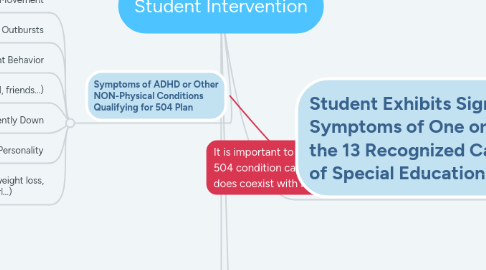
1. Symptoms of ADHD or Other NON-Physical Conditions Qualifying for 504 Plan
1.1. Constant Movement
1.2. Sudden Emotional Outbursts
1.3. Violent Behavior
1.4. Lack of Interest (in school, friends...)
1.5. Head Frequently Down
1.6. Change in Personality
1.7. Sudden Change in Appearance (weight loss, went from cheerleader to goth girl...)
2. Teacher Makes Recommendation to SST or School Psychologist
2.1. School Psychologist Initiates Parent Contact for Consent to Test Student (along with copy of FERPA)
2.1.1. Parent or Guardian Signature and Initial Conference with the Student Present Is Required Prior to conducting a Multi-Factor Evaluation (MFE)
2.2. Once paperwork, signatures, and legal documentation is in order, the psychologist administers the MFE.
2.3. The Student Study Team Reviews the MFE Results - all members make recommendations, and the child is assigned a CASE MANAGER (SpEd teacher) to observe and ultimately work with his or her regular ed teacher to write and implement his or her IEP or 504 plan.
3. Creating The IEP / 504 Accommodations
3.1. Unique for Each Child!
3.1.1. Assisstive Technology
3.1.1.1. Can range from pencil grips, to ear buds, to augmentative communication devices
3.1.2. Academic Learning Aids
3.1.2.1. software, calculators, graphic organizers
3.1.3. Computer Access
3.1.4. Recreation and Leisure Aids
3.1.5. Seating and Positioning
3.1.5.1. preferential seating, options for seating, etc.
3.1.6. Visual Aids
3.2. Behavior Plans Must Also Be Addressed
3.2.1. Some Students May REQUIRE a Positive Behavioral Support Plan as Part of his or her IEP or 504
3.2.1.1. Positive Reinforcement
3.2.1.2. Antecedent Strategies
3.2.1.3. Chaining - or building on previous positive behaviors
3.2.1.4. Student Self Monitoring
3.2.1.5. Labeled Praise (Giving praise for specific positive behaviors)
3.2.1.6. Cuing and Signaling
3.2.1.7. Proximity
3.2.1.8. Redirection
3.2.1.9. Relaxation Techniques
3.2.1.10. Conferencing
3.2.1.11. Contracts
3.2.1.12. Token Economies
3.3. Differentiated Instruction
3.3.1. Cooperative Learning
3.3.2. Modified Tests
3.3.3. Scaffolding / Instructions Explained and Modeled in Varying Ways
3.3.4. Materials at Reading Level
3.3.5. Extra Time on Tasks when Needed
3.3.6. Peer Mentor
3.3.7. Small Group Instruction and Testing when Needed
3.3.8. Options for Projects and Assessments
3.3.9. Preferential Seating
3.3.10. Audio Text/Books Available When Needed

